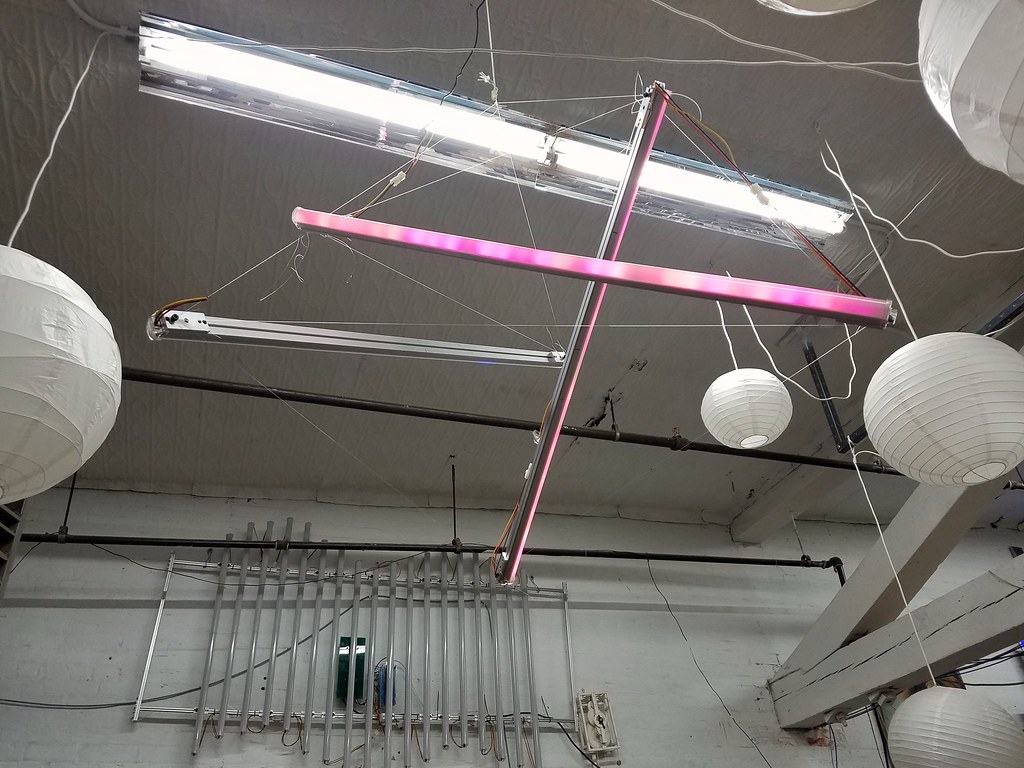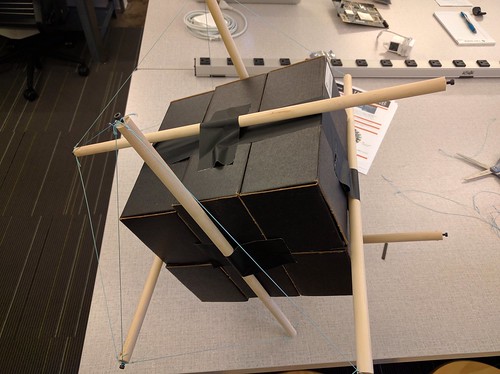Tensegrity
Tensegrity structures
 Tensegrity structures are characterized by having rigid rods connected by strings, in which none of the rods touch each other, yet are still rigidly positioned in space. This makes very lightweight art possible since most of the piece is air and string. The name was coined by Buckminster Fuller.
I saw Will Buchanan's "Intention" at Burning Man in 2016 and was inspired to build some of my own.
Tensegrity structures are characterized by having rigid rods connected by strings, in which none of the rods touch each other, yet are still rigidly positioned in space. This makes very lightweight art possible since most of the piece is air and string. The name was coined by Buckminster Fuller.
I saw Will Buchanan's "Intention" at Burning Man in 2016 and was inspired to build some of my own.
Fabric
 I realized that it was possible to create shade structures with tensegrity by replacing closed loops of string with fabric panels instead. This works well for the dodecahedron as well as the N-bar structures.
I realized that it was possible to create shade structures with tensegrity by replacing closed loops of string with fabric panels instead. This works well for the dodecahedron as well as the N-bar structures.
 The advantage is that the panels can be cut on the laser cutter, although it does require fairly tight tolerances to ensure that they will match the geometry of the bars.
The advantage is that the panels can be cut on the laser cutter, although it does require fairly tight tolerances to ensure that they will match the geometry of the bars.
N-Bar
 LED light bars make a fun N-bar tensegrity structure. An ideal setup would use thinner wires so that they aren't quite as obvious. This one is now hanging at NYC Resistor.
LED light bars make a fun N-bar tensegrity structure. An ideal setup would use thinner wires so that they aren't quite as obvious. This one is now hanging at NYC Resistor.
 N-Bar tesnsegrity structures can be created with half the number of knots by bringing all of the bars to the center section. This works well for fabric as well.
N-Bar tesnsegrity structures can be created with half the number of knots by bringing all of the bars to the center section. This works well for fabric as well.
 I really liked the tensegrity hammocks in Amsterdam and might make a similar structure for other events like Burning Man.
I really liked the tensegrity hammocks in Amsterdam and might make a similar structure for other events like Burning Man.
Tetrahedrons
 This laser cut tensegrity tetrahedral spine was an idea inspired by hdevalence on twitter.
This laser cut tensegrity tetrahedral spine was an idea inspired by hdevalence on twitter.
Jigs
 |
 |
Building the structures requires some sort of jig to hold the rods in position until all the strings are installed. My first attempt used a small block of wood and clamps, but suffered from the problem that this did not hold the ends of the rods in the correct locations. The third jig I built positioned them at the correct ½ way position -- the jig should be a cube half the length of the rods -- and allowed the strings to be looped over the end bolts. Once the last one was installed, I cut away the tape holding the boxes together and was able to thread them through the strings.
String lengths
 For my first attempt I noticed that there was a Eulerian circuit following the strings through the vertices. So I used a single piece of monofilament and traced that continuous path. It held together, almost!, until the string overcame friction and started to slide. Once some of the strings could become longer, it was no longer rigid and fell to pieces.
For my first attempt I noticed that there was a Eulerian circuit following the strings through the vertices. So I used a single piece of monofilament and traced that continuous path. It held together, almost!, until the string overcame friction and started to slide. Once some of the strings could become longer, it was no longer rigid and fell to pieces.
 My second version used wooden dowels and M3 bolts with loops cut into fishing line. This requires computing the correct length for the strings and pre-cutting them to the right size. The math behind this is to assume that the twelve vertices are at positions (±1,±x,0), (0,±1,±x), and (±x,0,±1), where x is unknown. This tells us that the length of the strings is L=√(1+(1-x)^2 + x2)=√(2-2x+2x2).
My second version used wooden dowels and M3 bolts with loops cut into fishing line. This requires computing the correct length for the strings and pre-cutting them to the right size. The math behind this is to assume that the twelve vertices are at positions (±1,±x,0), (0,±1,±x), and (±x,0,±1), where x is unknown. This tells us that the length of the strings is L=√(1+(1-x)^2 + x2)=√(2-2x+2x2).
We can see that there are two solutions for x for a given L, so let's find the double root by differentiating L^2 = 2 + 2x + 2x^2 as dy/dx = 2 + 4x, which implies that L has a minimum at x=½ and that the minimum string length is √(3/2). So in the above example, with 46cm rods the strings are 46/2 * √(1.5) = 28cm.
 If the strings are slightly longer the structure will oscillate between two points on either side of this minimum. This can be used to make mobile structures, which are proposed by NASA's SuperBall Bot. In my case the weight of the structure hanging from one vertex pulls into a stable configuration.
If the strings are slightly longer the structure will oscillate between two points on either side of this minimum. This can be used to make mobile structures, which are proposed by NASA's SuperBall Bot. In my case the weight of the structure hanging from one vertex pulls into a stable configuration.